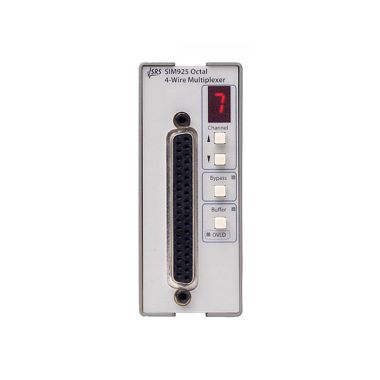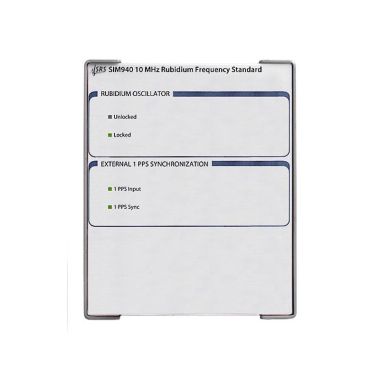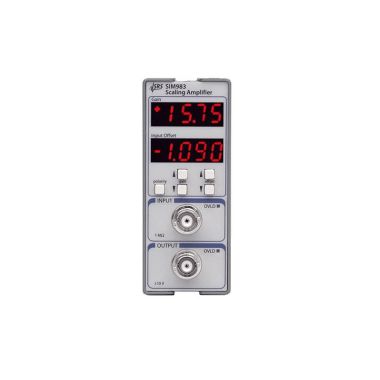SRS SIM900 Mainframe
- Rugged compact design
- 8 module slots
- 9th port for remote module
- 10 MHz reference with external sync
- Cascade multiple mainframes
- GPIB and RS-232 interfaces
- Start-up script memory
Lambda Exclusive Promotion:
Additional 12 months warranty for free (2 years total) via our UK Service Centre.
The Stanford Research Systems SIM (Small Instrumentation Modules) is a robust, flexible platform in which up to eight high performance instruments share the same compact mainframe and computer interface. Unlike other modular systems, both front-panel and computer operation are possible. With SIM you get the functionality you need while avoiding the cost of unnecessary features. You configure your own system from a broad and growing selection of modules.
The SRS SIM900 Mainframe is the platform on which a SIM system is assembled. The mainframe provides power, computer interfaces, clock synchronisation, and individual module status. Eight internal module slots accommodate single-width and double-width modules.
For the occasional application needing a module right next to an experiment, a rear-panel connector and an interconnect cable permit operation of a 9th module outside the mainframe.
CommunicationsThe mainframe comes with a standard RS-232 host interface and GPIB (IEEE-488.2) as an option. All commands and queries to individual modules are routed through the mainframe host interface. Messages are routed based on their port number, with the mainframe seamlessly relaying data to and from the appropriate destination. This messaging system is also used to communicate through the two auxiliary RS-232 ports. Using these ports, any number of SIM900 mainframes and other RS-232 instruments may be controlled through one host interface in the master mainframe.
Each port in the mainframe has independent 511-byte input and output queues. The mainframe also performs any rate adaptation needed when communicating through the ports. A dedicated "eavesdrop" RS-232 port provides an echo of all communications to and from the mainframe to ease debugging of new setups.
TimebaseThe mainframe provides a master 10 MHz clock to the modules which lock their internal timebases to this reference. The master clock in the SIM900 can be either free-running or phase-locked to an external 10 MHz reference through a rear-panel BNC input.
Start-Up ScriptA 4000 byte start-up script is maintained in non-volatile memory in the SIM900. When enabled, the commands stored in the script are executed each time the mainframe is turned on. This provides a simple way to ensure all modules are automatically set to a desired starting configuration.
Front PanelFront-panel LED indicators provide status information for the mainframe and also monitor communications between the host and installed modules. Indicators display host interface, timebase, communications status, start-up script, and power information.
Power SuppliesAll modules operate from various combinations of ±5 V, ±15 V and +24 V. These well regulated and filtered DC voltages are supplied by the mainframe power supply which is forced air cooled to maintain stable performance. All supplies are current limited with a trip-off circuit in case of an over voltage or short circuit.
| Module slots | 8 |
| Mainframe voltages | ±15 VDC, ±5 VDC, +24 VDC |
| Current limits | 5 A (max.) for +5 VDC |
| 3 A (max.) for -5 VDC, ±15 VDC and +24 VDC | |
| Power limit | 70 W total of all voltages |
| Voltage regulation | ±0.5 % |
| Internal timebase | 10 MHz VCXO, ±10 ppm |
| Host interfaces | RS-232/DCE |
| GPIB (optional) | |
| Module connector pins, DB15 (female): |
|
| 1 | Signal ground |
| 2 | -Status/service request |
| 3 | RTS flow ctrl |
| 4 | CTS flow ctrl |
| 5 | -10 MHz ref |
| 6 | -5 VDC |
| 7 | -15 VDC |
| 8 | Power ground |
| 9 | Chassis ground |
| 10 | TXD async data |
| 11 | RXD async data |
| 12 | +10 MHz ref |
| 13 | +5 VDC |
| 14 | +15 VDC |
| 15 | +24 VDC |
| Indicator lights: | |
| Interface | RS-232, GPIB |
| Timebase | Internal/External Lock, Fault |
| Activity | 8 slots, Remote SIM, Aux A, Aux B, Mainframe, Data Send, Data Receive, Data Error |
| Start script | Enabled |
| Power | On, Standby, Overload, Trip |
| Other connections: | Remote SIM DB15 connector |
| Aux. RS-232/DTE (2 ports) | |
| Eavesdrop RS-232/DCE | |
| 10 MHz timebase input BNC | |
| DIP switch for RS-232, GPIB & script enable | |
| Chassis ground terminal | |
| Operating temperature | 0 °C to 40 °C, non-condensing |
| Power requirements | 90 to 260 VAC, 47 to 63 Hz, 150 W (max.) |
| Dimensions: | |
| Mainframe | 17.0" × 5.3" × 9.0" (WHL) |
| Single-width module | 1.5" × 3.6" × 7.0" (WHL) |
| Double-width module | 3.0" × 3.6" × 7.0" (WHL) |
| Weight (empty) | 12.6 lbs. |
| Warranty | Two years parts and labour on defects in materials and workmanship |
![]() Stanford Research Systems SIM900 datasheet
Stanford Research Systems SIM900 datasheet
![]() Stanford Research Systems SIM900 operating manual
Stanford Research Systems SIM900 operating manual
![]() Why buying from Lambda makes sense
Why buying from Lambda makes sense




























